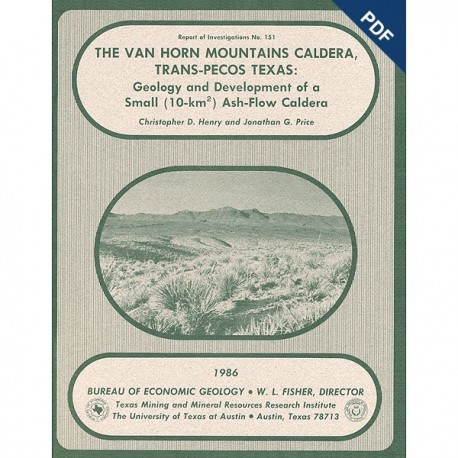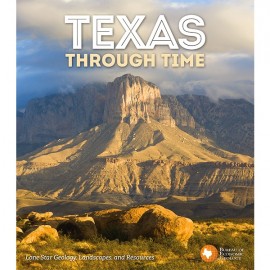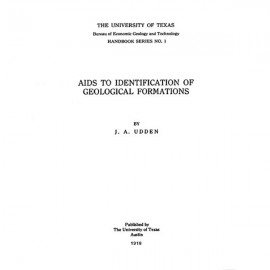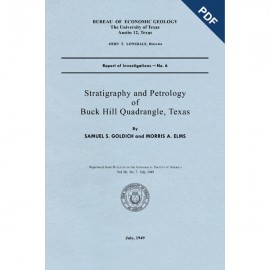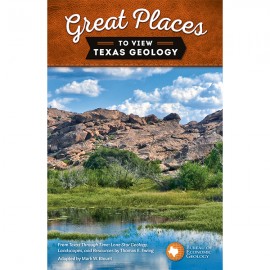Reports of Investigations
-
Books & Reports
- Reports of Investigations
- Guidebooks
- Udden Series
- Geological Circulars
- Down To Earth
- Atlases of Major Oil and Gas Reservoirs
- Texas Memorial Museum Publications
- Environmental Geologic Atlas of the Texas Coastal Zone
- Mineral Resource Circulars
- Other Reports
- Seminars and Workshops
- Handbooks
- Submerged Lands of Texas
- Symposia
- Annual Reports
- Open File Reports
-
Maps & Cross Sections
- Thematic Maps
- Miscellaneous Maps, Charts & Sections
- Geologic Atlas of Texas
- STATEMAP Project Maps
- Geologic Quadrangle Maps
- Cross Sections
- Highway Geology Map
- Energy and Mineral Resource Maps
- Shoreline Change and Other Posters
- Wilcox Group, East Texas, Geological / Hydrological Folios
- Bouguer Gravity Atlas of Texas
- River Basin Regional Studies
- Featured Maps
- Posters
- Teachers & the Public
-
Geological Society Publications
- Gulf Coast Association of Geological Societies
- Alabama Geological Society
- Austin Geological Society
- Corpus Christi Geological Society
- Houston Geological Society
- Lafayette Geological Society
- Mississippi Geological Society
- New Orleans Geological Society
- South Texas Geological Society
- GCS SEPM Publications
- Historic BEG & UT Series
The Van Horn Mountains Caldera, Trans-Pecos Texas: Geology ... Digital Download
RI0151D
A free, digital version of this publication can be found on: Texas ScholarWorks
To purchase a print version (if available): RI0151
RI0151D. The Van Horn Mountains Caldera, Trans-Pecos Texas: Geology and Development of a Small (10-km2) Ash-Flow Caldera, by C. D. Henry and J. G. Price. 46 p., 31 figs., 3 tables, 1 plate, 1 appendix, 1986. doi.org/10.23867/RI0151D. Downloadable PDF.
To purchase this publication in book format, please order RI0151.
ABSTRACT
The Van Horn Mountains caldera is a small (~10-km2) igneous center in the Trans-Pecos volcanic province. The caldera formed 37 to 38 mya during eruption of the first of two ash-flow tuffs related to the caldera. Part of the first tuff ponded within the caldera; the lower marker horizon of the Chambers Tuff in the Sierra Vieja south of the Van Horn Mountains is probably the correlative outflow tuff. Following collapse, the caldera was partly filled by a heterogeneous assemblage of air-fall tuff, tuffaceous sediment, and possible ash-flow tuff. Contemporaneous with this filling, a rhyolite porphyry was emplaced in the middle of the caldera. The porphyry is comparable to the resurgent dome of other calderas but does not uplift the intruded rocks. An intrusive-extrusive complex of basalt, trachyte, and minor rhyolite was emplaced just outside the eastern margin of the caldera; flows from this complex spilled over the rim and into the caldera. Eruption of a second major ash-flow tuff, herein named the High Lonesome Tuff, may have led to additional collapse.
Collapse occurred dominantly along a single, major, nearly circular fracture zone. Embayments in the fracture zone were influenced by precaldera, largely Laramide structures. Large, commonly brecciated blocks of wall rocks slumped into the caldera and were incorporated into caldera fill. Precaldera topography channeled most of the ash-flow tuff to the south, through a low area in the caldera wall.
The 10-km2 area of the caldera and the no more than 10-km total volume of erupted ash-flow tuff make it one of the smallest ash-flow calderas worldwide and more comparable to collapse features associated with stratovolcanoes. Nevertheless, it shows all the features typical of much larger volcanic centers.
No known ore deposits are associated with the caldera, but the rhyolite porphyry is hydrothermally altered, exhibiting silicification and sericitization typical of many porphyry molybdenum deposits. The apparent lack of deposits may be a function of the small size of the magmatic system, lack of sufficient trace element enrichment by differentiation, or lack of exposure resulting from minimal erosion.
Keywords: ash-flow tuff, caldera, igneous rocks, K-Ar, Trans-Pecos Texas
CONTENTS
ABSTRACT
INTRODUCTION
REGIONAL SETTING
PURPOSE
STRATIGRAPHY
PRECAMBRIAN ROCKS
PERMIAN ROCKS
CRETACEOUS ROCKS
TERTIARY ROCKS
Colmena Formation
Buckshot lgnimbrite
Rocks of the Van Horn Mountains caldera
Garden of the Gods intrusion
Caldera-forming ash-'flow tuff
Lower marker horizon of the Chambers Tuff.
Rhyolite porphyry intrusion
Tuff-breccia
Hogeye Tuff
Intrusive-extrusive complex
Field relations
Petrography
High Lonesome Tuff
Tuffaceous sediments above the High Lonesome Tuff
Trachyte of High Lonesome Peak
Miocene to Recent basin fill
QUATERNARY DEPOSITS WITHIN THE VAN HORN MOUNTAINS CALDERA
GEOCHEMISTRY
STRUCTURE
PRECAMBRIAN DEFORMATION
LATE PENNSYLVANIAN - EARLY PERMIAN UPLIFT
LARAMIDE FOLDING AND THRUSTING
CALDERA STRUCTURE
BASIN AND RANGE DEFORMATION.
ECONOMIC GEOLOGY
HYDROTHERMAL ALTERATION ASSOCIATED WITH THE RHYOLITE PORPHYRY OF
THE VAN HORN MOUNTAINS CALDERA
MICA
BUILDING STONE AND CRUSHED ROCK
MANGANESE AND BARITE
SILVER AND OTHER METALS
LACK OF MAJOR MINERAL DEPOSITS ASSOCIATED WITH THE VAN HORN MOUNTAINS CALDERA
GEOLOGIC HISTORY OF TERTIARY VOLCANISM
CALDERA SIZE AND ASH-FLOW TUFF VOLUMES: IMPLICATIONS FOR ERUPTION AND SUBSIDENCE
COMPARISON WITH PUBLISHED CALDERA MODELS
ACKNOWLEDGMENTS
REFERENCES
APPENDIX
Figures
1. Location of the Van Horn Mountains caldera in the volcanic field of Trans-Pecos Texas
2. Generalized geologic mop of the Van Horn Mountains caldera
3. Pre-Cenozoic stratigraphic column, Van HornMountains, Texas
4. Correlation of regional volcanic units, Van Horn Mountains and northern Sierra Vieja
5. Buckshot lgnimbrite overlying conglomerate in Colmeno Formation
6. Blister cone on upper surface of the Buckshot lgnimbrite
7. Intrusive contact of Gorden of the Gods rhyolite with the Buckshot lgnimbrite
8. Photomicrograph of quartz phenocrysts in groundmass of quartz, alkali feldspar, and opaque minerals, Garden of the Gods rhyolite
9a. Outcrop of caldera-forming ash-flow tuff showing abundant small rock fragments in a gray, devitrified but nonwelded matrix
9b. Photomicrograph of caldera-forming ash-flow tuff
10a. Possible flow of rhyolite porphyry extending as a flat lobe west of the main moss of the intrusion
10b. Photomicrograph of rhyolite porphyry with quartz and altered alkali feldspar phenocrysts
11. Outcrop of rhyolite porphyry overlain by tuff-breccia
12. Dike of flow-bonded rhyolite porphyry intruded into tuff·breccia
13. Tuff-breccia consisting of rhyolite porphyry, pumice, and pre-Tertiary rock fragments in a tuffaceous matrix
14a. Crudely bedded tuff-breccia
14b. Channel filled with water-laid tuff
15. Extremely coarse tuff-breccia with randomly oriented blocks of Cretaceous rocks
16. Internal brecciation of a 50-m block of Cox Sandstone within tuff-breccia
17. Volcanic stratigraphy within and near the Van Horn Mountains caldera
18. Fluvial tuffaceous sediments in the Hogeye Tuff
19a. Hill of intrusive trachyte cut into gently dipping Cretaceous rocks
19b. Concentric, vertical bonds of resistant trachyte and nonresistant tuff within the intrusive-extrusive complex
20. Photomicrograph of basalt with olivine and clinopyroxene phenocrysts
21. Photomicrograph of trachyte with clinopyroxene and plagioclase phenocrysts
22. Thick High Lonesome Tuff overlying the Hogeye Tuff
23. Known distribution of High Lonesome Tuff
24. Photomicrograph of High Lonesome Tuff vitrophyre with phenocrysts of alkali feldspar, clinopyroxene, and various opaque minerals
25. AFM plot of rocks from the Van Horn Mountains caldera
26. Harker variation diagram of total alkalis and CaO plotted against SiO2
27. Harker variation diagram of TiO2 plotted against SiO2
28. Harker variation diagram of Sr plotted against SiO2
29. Western topographic wall of caldera
30. Large slump block of Cretaceous rocks along western caldera wall
31. Paleotopography of the Van Horn Mountains caldera area at the time of caldera formation
Tables
1. Chemical analyses of rocks from the Van Horn Mountains caldera
2. Chemical analyses of rhyolite porphyry with stockwork quartz veinlets, Van Horn Mountains
3. K-Ar ages of rocks of the Van Horn Mountains caldera
Plate
Geologic map of Van Horn Mountains caldera
Citation
Henry, C. D., and Price, J. G., 1986, The Van Horn Mountains Caldera, Trans-Pecos Texas: Geology and Development of a Small (10-km2) Ash-Flow Caldera: The University of Texas at Austin, Bureau of Economic Geology, Report of Investigations No. 151, 46 p.
